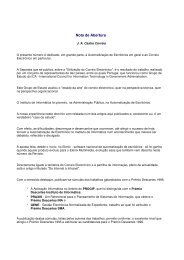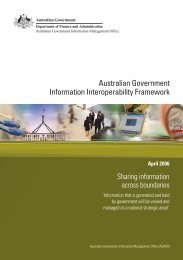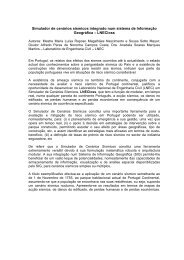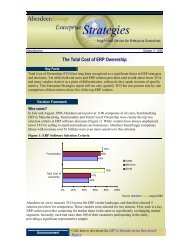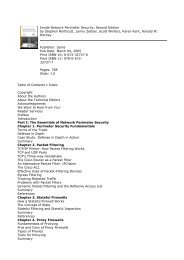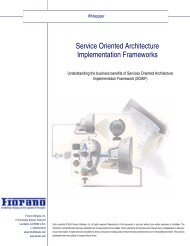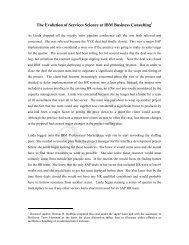OECD Peer Review of E-Government in Denmark - ePractice.eu
OECD Peer Review of E-Government in Denmark - ePractice.eu
OECD Peer Review of E-Government in Denmark - ePractice.eu
Create successful ePaper yourself
Turn your PDF publications into a flip-book with our unique Google optimized e-Paper software.
Danish approach <strong>of</strong> flexible decentralised development <strong>of</strong> e-government based on a common<br />
architecture and standards.<br />
Observations<br />
The two standards-based <strong>in</strong>itiatives described above present a contrast <strong>in</strong> terms <strong>of</strong> the pace <strong>of</strong><br />
achievement <strong>of</strong> strategic goals that have been set for the health sector. While <strong>Denmark</strong> is<br />
acknowledged as hav<strong>in</strong>g made impressive progress with the overall development <strong>of</strong> e-government <strong>in</strong><br />
its health sector, the development <strong>of</strong> its common health data network has occurred more steadily and<br />
quickly than its implementation <strong>of</strong> EHRs.<br />
There are a number <strong>of</strong> reasons for this situation. First, electronic transmission <strong>of</strong> health data is a<br />
more straightforward and non-controversial activity than the design and implementation <strong>of</strong> EHRs.<br />
Transmission <strong>of</strong> electronic messages between different health organisations is clearly much more a<br />
technological challenge than the bus<strong>in</strong>ess <strong>of</strong> def<strong>in</strong><strong>in</strong>g and implement<strong>in</strong>g standards relat<strong>in</strong>g to the<br />
structure and content <strong>of</strong> such messages. Second, def<strong>in</strong><strong>in</strong>g standards for EHRs is very complex for two<br />
reasons – the sheer variety <strong>of</strong> potential EHR standards that need to be taken <strong>in</strong>to account (especially <strong>in</strong><br />
the pan-European context), and the fact that an EHR must meet the sometimes very different<br />
requirements <strong>of</strong> cl<strong>in</strong>icians and hospital adm<strong>in</strong>istrators.<br />
A third factor that has slowed nation-wide implementation <strong>of</strong> EHRs is the impact that the<br />
Structural Reform is hav<strong>in</strong>g on the health sector, impos<strong>in</strong>g a major reorganisation <strong>of</strong> hospitals, and a<br />
reallocation <strong>of</strong> service delivery responsibilities that sees municipalities play<strong>in</strong>g a larger role <strong>in</strong> the<br />
health sector <strong>in</strong> the future. While some commentators feel that the Structural Reform presents a<br />
strategic opportunity to make significant progress towards the goal <strong>of</strong> a fully standardised and<br />
<strong>in</strong>teroperable health ICT environment, the weight <strong>of</strong> op<strong>in</strong>ion is that the organisational changes already<br />
imposed by the Reform are <strong>of</strong> such magnitude that add<strong>in</strong>g a further drive towards health ICT goals to<br />
these changes would risk successful implementation <strong>of</strong> the Reform as currently proposed, and also<br />
threaten the cont<strong>in</strong>uity and quality <strong>of</strong> service provision through the reform period.<br />
A fourth factor beh<strong>in</strong>d the slower pace <strong>of</strong> EHR development is the major <strong>in</strong>vestments that health<br />
sector organisations (especially hospitals) have each made <strong>in</strong> their current cl<strong>in</strong>ical and adm<strong>in</strong>istrative<br />
systems and surround<strong>in</strong>g bus<strong>in</strong>ess processes. Each organisation has taken its own approach to systems<br />
and processes, mean<strong>in</strong>g that as well as be<strong>in</strong>g faced with significant costs <strong>of</strong> change they also face a<br />
very complicated environment for achiev<strong>in</strong>g <strong>in</strong>teroperability. These costs and complexities are not<br />
evenly spread among all actors, mean<strong>in</strong>g that each has differ<strong>in</strong>g <strong>in</strong>centives and challenges to face <strong>in</strong><br />
arriv<strong>in</strong>g at some satisfactory sector-wide and collaborative outcome. Discussions about this with<br />
representatives <strong>of</strong> a number <strong>of</strong> Danish regions highlighted the existence <strong>of</strong> strong and divergent vested<br />
<strong>in</strong>terests act<strong>in</strong>g as obstacles to f<strong>in</strong>d<strong>in</strong>g the most optimal way forward with the implementation <strong>of</strong><br />
EHRs.<br />
Conclusion<br />
Health care is one <strong>of</strong> the most complex areas for e-government implementation <strong>in</strong> <strong>OECD</strong><br />
countries. It is an area where significant outcomes h<strong>in</strong>ge upon the way that <strong>in</strong>formation is used, both <strong>in</strong><br />
service delivery and back-<strong>of</strong>fice adm<strong>in</strong>istration. There is a very high requirement to ensure the privacy<br />
and security <strong>of</strong> health <strong>in</strong>formation, and high costs associated with the development and operation <strong>of</strong><br />
health ICT systems and applications. There is also <strong>of</strong>ten a significant difference between the goals,<br />
<strong>in</strong>centives, views, knowledge and skills, and <strong>in</strong>formational requirements <strong>of</strong> hospital adm<strong>in</strong>istrators,<br />
cl<strong>in</strong>icians and vendors <strong>of</strong> health sector ICT products and services.<br />
154



